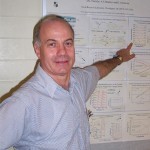Illuminating Light
The Landau Prize for the Sciences and Research to be Awarded to Technion Professor David Gershoni, for his Research Contributions Leading to the Production of Entangled Photons
Prof. David Gershoni, from the Department of Physics at the Technion, will receive the 2014 Michael Landau Prize for Sciences and Research awarded by Mifal Hapais (the Israel State Lottery) enterprise, for his research contributions, which have led to the development of a prototype for producing entangled photon emissions. The Prize Committee noted that “This method is significantly different from its predecessors; its advantage lies in its capability to create multiple devices and thereby generate entangled photons on demand. This has important experimental implications for research in the field of quantum information.”
Prof. Gershoni earned his academic degrees at the Technion. In 1986 (at age 33) he pursued his postdoctoral studies at Bell Laboratories headquarters in New Jersey, and after one short year he was accepted there as a faculty member and engaged in research and development. In 1991 he returned to Israel and the Technion, this time as a faculty member at the Department of Physics.
In 2006, Prof. Gershoni proved the possibility of producing entangled photons (particles of light) from semiconductor sources. Entanglement is a phenomenon whereby two quantum particles behave like physical twins that maintain a quantum correlation: when a characteristic of one of the particles changes, the characteristic of its twin simultaneously changes as well, making it impossible to describe the state of one of the particles separately from the state of the other.
In a joint research study with Prof. Joseph Avron from the Department of Physics at the Technion and doctoral students Nika Akopian and Netanel Lindner, Prof. Gershoni demonstrated – both theoretically and experimentally – that under appropriate conditions, an efficient prototype semiconductor-based light source of nanoscale dimensions produces entangled light. The researchers showed that it is possible to build a device based on such a source, which would be capable of producing entangled photons ‘on demand’ – a significant milestone for quantum communications, quantum information processing,computing, and perhaps even teleportation.
“Spooky action at a distance”
Quantum entanglement is a physical phenomenon that first appeared in a 1935 paper authored by Albert Einstein, Boris Podolsky and Nathan Rosen (one of the founding fathers of the Physics Department at the Technion) and became known as the EPR paradox (EPR stood for their initials). The paper expressed reservations about Einstein’s accepted formulation of quantum mechanics, which allegedly ‘allows’ for information to travel at light speed. Einstein believed that the ‘possibility’ for such behavior is fictitious, or as he put it: ‘spooky action at a distance.’
Niels Bohr, among the fathers of quantum mechanics, claimed in response to the paper on the EPR paradox that this ‘remote operation’ is actually possible, since it is based not on ‘mechanical impact’, but on the ‘logical effect,’ on the conditions that define the behavior of the system. Einstein then retaliated by describing Bohr’s response as “longwinded Talmudic gibberish.”
In 1962, Irish physicist John Bell, demonstrated that the Einstein-Bohr debate could be resolved experimentally. In research trials conducted in the 70s and 80s, as a result of a mathematical model formulated by Bell, it was scientifically proven that entangled particles are indeed endowed with an exceptional correlation that predicts quantum mechanics. The research by Professors Gershoni and Avron, which is based in part on the theoretical work of a former faculty member, the late Distinguished Professor Asher Peres, led to a breakthrough in this direction.
’In effect, we demonstrated how to develop a device that “shoots” entangled photonic pairs on demand,’ explains Prof. Gershoni. “This discovery is an important milestone bridging current technology (classical) and future technologies (quantum). The current technology, which includes computers, communications, lighting, data storage and processing of information, is based on semiconductors, and this is why our discovery is extremely relevant to the high-tech world. We are developing nano-scale semiconductor structures operating as ‘artificial atoms’ whose behavior may be explained and predicted using quantum mechanics. We believe that this breakthrough will advance the field of quantum information processing, which will form the basis of future technologies. Our research motivation stems also from our hope that technology will follow science and that in the near future we will be able to see a wide use of real quantum technology.”
The Landau Prize for Sciences and Research awarded by Mifal Hapais is bestowed on scientists who have made significant achievements and valuable contributions to the advancement of science and research. The Prize Committee selected Prof. Gershoni as this year’s winner of the Physics award; prize committee members include Professors Dan Shahar, Shmuel Fishman and Ora Entin-Wohlman . Landau prize winners in other categories are: Prof. Dana Wolf (Virology), Prof. Elisha Qimron (Hebrew language research), Prof. Amir Sagi (Agriculture), Prof. Howard Litvin (Gerontology), and Prof. Daniel Hanoch Wagner (Chemical and Materials engineering).
The research is being carried out in collaboration with the Russell Berrie Nanotechnology Institute.
In the photo: Prof. David Gershoni
Photo Credit: The Technion’s Spokesperson’s Office
For additional information: Gil Liner, Technion Spokesperson, 058-688-2208.



